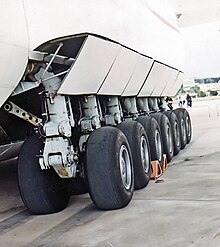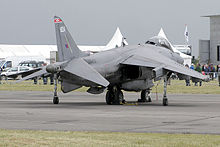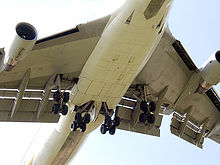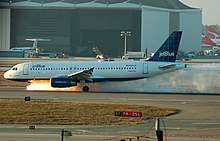 Helsinki-Vantaa Airport, runway 33
Helsinki-Vantaa Airport, runway 33By extension, the term has also come to mean any long, flat, straight area, such as that used in fashion shows.
Orientation and dimensions
If there is more than one runway pointing in the same direction (parallel runways), each runway is identified by appending Left (L), Center (C) and Right (R) to the number — for example, Runways One Five Left (15L), One Five Center (15C), and One Five Right (15R). Runway Zero Three Left (03L) becomes Runway Two One Right (21R) when used in the opposite direction (derived from adding 18 to the original number for the 180 degrees when approaching from the opposite direction).
At large airports with more than three parallel runways (for example, at Los Angeles, Detroit Metropolitan Wayne County, Hartsfield-Jackson Atlanta, Denver, and Dallas-Fort Worth), some runway identifiers are shifted by 10 degrees to avoid the ambiguity that would result with more than three parallel runways. For example, in Los Angeles, this system results in Runways 6L, 6R, 7L, and 7R, even though all four runways are exactly parallel (approximately 69 degrees). At Dallas-Fort Worth, there are five parallel runways, named 17L, 17C, 17R, 18L, and 18R, all oriented at a heading of 175.4 degrees.
For clarity in radio communications, each digit in the runway name is pronounced individually: runway three six, runway one four, etc. A leading zero, for example in "runway zero six" or "runway zero one left", is included for International Civil Aviation Organization (ICAO) and some United States military airports (such as Edwards Air Force Base). However in the United States at most civil aviation airports, the leading zero is often dropped. This also includes some military airfields such as Cairns Army Airfield. This American anomaly may lead to inconsistencies in conversations between American pilots and controllers in other countries. It is very common in a country such as Canada for a controller to clear an incoming American aircraft to, for example, Runway 04, and the pilot read back the clearance as Runway 4. In flight simulation programs those of American origin might apply U.S. usage to airports around the world. For example Runway 05 at Halifax will appear on the program as the single digit 5 rather than 05.
Runway designations change over time because the magnetic poles slowly drift on the Earth's surface and the magnetic bearing will change. Depending on the airport location and how much drift takes place, it may be necessary over time to change the runway designation. As runways are designated with headings rounded to the nearest 10 degrees, this will affect some runways more than others. For example, if the magnetic heading of a runway is 233 degrees, it would be designated Runway 23. If the magnetic heading changed downwards by 5 degrees to 228, the Runway would still be Runway 23. If on the other hand the original magnetic heading was 226 (Runway 23), and the heading decreased by only 2 degrees to 224, the runway should become Runway 22. Because the drift itself is quite slow, runway designation changes are uncommon, and not welcomed, as they require an accompanying change in aeronautical charts and descriptive documents. When runway designations do change, especially at major airports, it is often changed overnight as taxiway signs need to be changed and the huge numbers at each end of the runway need to be repainted to the new runway designators. In July 2009 for example, London Stansted Airport in the United Kingdom changed its runway designations from 05/23 to 04/22 overnight.
For fixed-wing aircraft it is advantageous to perform take-offs and landings into the wind to reduce takeoff roll and reduce the ground speed needed to attain flying speed. Larger airports usually have several runways in different directions, so that one can be selected that is most nearly aligned with the wind. Airports with one runway are often constructed to be aligned with the prevailing wind.Runway dimensions vary from as small as 245 m (804 ft) long and 8 m (26 ft) wide in smaller general aviation airports, to 5,500 m (18,045 ft) long and 80 m (262 ft) wide at large international airports built to accommodate the largest jets, to the huge 11,917 m (39,098 ft) x 274 m (899 ft) lake bed runway 17/35 at Edwards Air Force Base in California - a landing site for the Space Shuttle.
Placement and grouping
Two runways pointing in the same direction are classed as dual or parallel runways depending on the separation distance. In some countries, flight rules mandate that only one runway may be used at a time under certain conditions (usually adverse weather) if the parallel runways are too close to each other.Declared distances
- TORA
- Takeoff Run Available - The length of runway declared available and suitable for the ground run of an airplane taking off.
- TODA
- Takeoff Distance Available - The length of the takeoff run available plus the length of the clearway, if clearway is provided.
- ASDA
- Accelerate-Stop Distance Available - The length of the takeoff run available plus the length of the stopway, if stopway is provided.
- LDA
- Landing Distance Available - The length of runway which is declared available and suitable for the ground run of an airplane landing.
- EDA
- Emergency Distance Available - LDA (or TORA) plus a stopway.
Sections of a runway
- The Runway Safety Area is the cleared, smoothed and graded area around the paved runway. It is kept free from any obstacles that might impede flight or ground roll of aircraft.
- The Runway is the surface from threshold to threshold, which typically features threshold markings, numbers, centerlines, but not overrun areas at both ends.
- Blast pads, also known as overrun areas or stopways, are often constructed just before the start of a runway where jet blast produced by large planes during the takeoff roll could otherwise erode the ground and eventually damage the runway. Overrun areas are also constructed at the end of runways as emergency space to slowly stop planes that overrun the runway on a landing gone wrong, or to slowly stop a plane on a rejected takeoff or a take-off gone wrong. Blast pads are often not as strong as the main paved surface of the runway and are marked with yellow chevrons. Planes are not allowed to taxi, take-off or land on blast pads, except in an emergency.
- Displaced thresholds may be used for taxiing, takeoff, and landing rollout, but not for touchdown. A displaced threshold often exists because obstacles just before the runway, runway strength, or noise restrictions may make the beginning section of runway unsuitable for landings. It is marked with white paint arrows that lead up to the beginning of the landing portion of the runway.
Runway lighting
History
The first runway lighting appeared in 1930 at Cleveland Municipal Airport (now known as Cleveland Hopkins International Airport) in Cleveland, Ohio. A line of lights on an airfield or elsewhere to guide aircraft in taking off or coming in to land or an illuminated runway is sometimes also known as a flare path.Technical specifications
Runway lighting is used at airports which allow night landings. Seen from the air, runway lights form an outline of the runway. A particular runway may have some or all of the following.- Runway End Identification Lights (REIL) – unidirectional (facing approach direction) or omnidirectional pair of synchronized flashing lights installed at the runway threshold, one on each side.
- Runway end lights – a pair of four lights on each side of the runway on precision instrument runways, these lights extend along the full width of the runway. These lights show green when viewed by approaching aircraft and red when seen from the runway.
- Runway edge lights – white elevated lights that run the length of the runway on either side. On precision instrument runways, the edge-lighting becomes yellow in the last 2,000 ft (610 m) of the runway. Taxiways are differentiated by being bordered by blue lights, or by having green centre lights, depending on the width of the taxiway, and the complexity of the taxi pattern.
- Runway Centerline Lighting System (RCLS) – lights embedded into the surface of the runway at 50 ft (15 m) intervals along the runway centerline on some precision instrument runways. White except the last 3,000 ft (914 m), alternate white and red for next 2,000 ft (610 m) and red for last 1,000 ft (305 m).
- Touchdown Zone Lights (TDZL) – rows of white light bars (with three in each row) on either side of the centerline over the first 3,000 ft (914 m) (or to the midpoint, whichever is less) of the runway.
- Taxiway Centerline Lead-Off Lights – installed along lead-off markings, alternate green and yellow lights embedded into the runway pavement. It starts with green light about runway centerline to the position of first centerline light beyond holding position on taxiway.
- Taxiway Centerline Lead-On Lights – installed the same way as taxiway centerline lead-off Lights.
- Land and Hold Short Lights – a row of white pulsating lights installed across the runway to indicate hold short position on some runways which are facilitating land and hold short operations (LAHSO).
- Approach Lighting System (ALS) – a lighting system installed on the approach end of an airport runway and consists of a series of lightbars, strobe lights, or a combination of the two that extends outward from the runway end.
The edge lights must be arranged such that:
- the minimum distance between lines is 75 ft (23 m), and maximum is 200 ft (61 m);
- the maximum distance between lights within each line is 200 ft (61 m);
- the minimum length of parallel lines is 1,400 ft (427 m);
- the minimum number of lights in the line is 8.
Runway markings

There are three types of runways:
- visual Runways are used at small airstrips and are usually just a strip of grass, gravel, asphalt or concrete. Although there are usually no markings on a visual runway, they may have threshold markings, designators, and centerlines. Additionally, they do not provide an instrument-based landing procedure; pilots must be able to see the runway to use it. Also, radio communication may not be available and pilots must be self-reliant.
- non-precision instrument runways are often used at small- to medium-size airports. These runways, depending on the surface, may be marked with threshold markings, designators, centerlines, and sometimes a 1,000 ft (305 m) mark (known as an aiming point, sometimes installed at 1,500 ft (457 m)). They provide horizontal position guidance to planes on instrument approach via Non-directional beacon (NDB), VHF omnidirectional range (VOR), Global Positioning System, etc.
- precision instrument runways, which are found at medium- and large-size airports, consist of a blast pad/stopway (optional, for airports handling jets), threshold, designator, centerline, aiming point, and 500 ft (152 m), 1,000 ft (305 m)/1,500 ft (457 m), 2,000 ft (610 m), 2,500 ft (762 m), and 3,000 ft (914 m) touchdown zone marks. Precision runways provide both horizontal and vertical guidance for instrument approaches.
National variants
- In Australia, Canada, Japan, the United Kingdom, as well as some other countries all 3-stripe and 2-stripe touchdown zones for precision runways are replaced with one-stripe touchdown zones.
- In Australia, precision runways consist of only an aiming point and one 1-stripe touchdown zone. Furthermore, many non-precision and visual runways lack an aiming point.
- In some Latin American countries like Colombia, Ecuador and Peru one 3-stripe is added and a 2-stripe is replaced with the aiming point .
- Some European countries replace the aiming point with a 3-stripe touchdown zone.
- Runways in Norway have yellow markings instead of the usual white ones. This also occurs on some airports in Japan. The yellow markings are used to ensure better contrast against snow.
- Runways may have different types on each end. To cut costs, many airports do not install precision guidance equipment on both ends. Runways with one precision end and any other type of end can install the full set of touchdown zones, even if some are past the midpoint. If a runway has precision markings on both ends, touchdown zones within 900 ft (274 m) of the midpoint are omitted, to avoid pilot confusion over which end the marking belongs to.
Runway safety
Runway excursion is an incident involving only a single aircraft where it makes an inappropriate exit from the runway. This can happen because of pilot error, poor weather, emergency, or a fault with the aircraft. Overrun is a type of excursion where the aircraft is unable to stop before the end of the runway. An example of such an event is Air France Flight 358 in 2005. Further examples can be found in the overruns category. Runway excursion is the most frequent type of landing accident, slightly ahead of runway incursion. For runway accidents recorded between 1995 and 2007, 96% were of the 'excursion' type.Runway event is another term for a runway accident.
Runway incursion involves a first aircraft, as well as a second aircraft, vehicle, or person. It is defined by the U.S. Federal Aviation Administration (FAA) as: "Any occurrence at an aerodrome involving the incorrect presence of an aircraft, vehicle or person on the protected area of a surface designated for the landing and take off of aircraft."
Runway confusion involves a single aircraft, and is used to describe the error when the aircraft makes "the unintentional use of the wrong runway, or a taxiway, for landing or take-off".
The U.S. FAA publishes an annual report on runway safety issues, available from the FAA website. New systems designed to improve runway safety, such as Airport Movement Area Safety System (AMASS) and Runway Awareness and Advisory System (RAAS), are discussed in the report. AMASS prevented the serious near-collision in the 2007 San Francisco International Airport runway incursion.
Runway condition is also an important parameter related to meteorological conditions and air safety.
- Dry: the surface of the runway is clear of water, snow or ice.
- Damp: change of color on the surface due to moisture.
- Wet: the surface of the runway is soaked but there is no significant patches of standing water.
- Water patches: patches of standing water are visible.
- Flooded: there is extensive standing water.
Pavement
For pavement designs, borings are taken to determine the subgrade condition, and based on the relative bearing capacity of the subgrade, the specifications are established. For heavy-duty commercial aircraft, the pavement thickness, no matter what the top surface, varies from 10 in (250 mm) to 4 ft (1 m), including subgrade.
Airport pavements have been designed by two methods. The first, Westergaard, is based on the assumption that the pavement is an elastic plate supported on a heavy fluid base with a uniform reaction coefficient known as the K value. Experience has shown that the K values on which the formula was developed are not applicable for newer aircraft with very large footprint pressures.
The second method is called the California bearing ratio and was developed in the late 1940s. It is an extrapolation of the original test results, which are not applicable to modern aircraft pavements or to modern aircraft landing gear. Some designs were made by a mixture of these two design theories.
A more recent method is an analytical system based on the introduction of vehicle response as an important design parameter. Essentially it takes into account all factors, including the traffic conditions, service life, materials used in the construction, and, especially important, the dynamic response of the vehicles using the landing area.
Because airport pavement construction is so expensive, every effort is made to minimize the stresses imparted to the pavement by aircraft. Manufacturers of the larger planes design landing gear so that the weight of the plane is supported on larger and more numerous tires. Attention is also paid to the characteristics of the landing gear itself, so that adverse effects on the pavement are minimized. Sometimes it is possible to reinforce a pavement for higher loading by applying an overlay of asphaltic concrete or portland cement concrete that is bonded to the original slab.
Post-tensioning concrete has been developed for the runway surface. This permits the use of thinner pavements and should result in longer concrete pavement life. Because of the susceptibility of thinner pavements to frost heave, this process is generally applicable only where there is no appreciable frost action.
Pavement surface
Runway pavement surface is prepared and maintained to maximize friction for wheel braking. To minimize hydroplaning following heavy rain, the pavement surface is usually grooved so that the surface water film flows into the grooves and the peaks between grooves will still be in contact with the aircraft tires. To maintain the macrotexturing built into the runway by the grooves, maintenance crews engage in airfield rubber removal or hydrocleaning in order to meet required FAA friction levels.Surface Type Codes
In aviation charts, the surface type is usually abbreviated to a three-letter code.The most common hard surface types are Asphalt and Concrete. The most common soft surface types are Grass and Gravel.
- ASP: Asphalt
- BIT: Bitumenous Asphalt or Tarmac
- BRI: Bricks (no longer in use, covered with Asphalt or Concrete now)
- CLA: Clay
- COM: Composite
- CON: Concrete
- COP: Composite
- GRS: Grass or earth not graded or rolled
- COR: Coral (Coral reef structures)
- GRE: Graded or rolled earth, Grass on graded earth
- GVL: Gravel
- LAT: Laterite
- ICE: Ice
- MAC: Macadam
- PEM: Partially Concrete, Asphalt or Bitumen-bound Macadam
- PER: Permanent Surface, Details unknown
- PSP: Marsden Matting (Derived from Pierced/Perforated Steel Planking)
- SAN: Sand
- SNO: Snow
- U: Unknown surface
Active runway
Selection of the active runway, however, depends on a number of factors. At a non-towered airport, pilots usually select the runway most nearly aligned with the wind, but they are not obliged to use that particular runway. For example, a pilot arriving from the east may elect to land straight in to an east-west runway despite a minor tailwind or significant crosswind, in order to expedite his arrival, although it is recommended to always fly a regular traffic pattern to more safely merge with other aircraft.
At controlled airports, the active is usually determined by a tower supervisor. However, there may be constraints, such as policy from the airport manager (calm wind runway selection, for example, or noise abatement guidelines) that dictate an active runway selection that is not the one most nearly aligned with the wind.
At major airports with multiple runways, the active could be any of a number of runways. For example, when O'Hare (ORD) is landing on 27L and 32L, departures use 28 and 32R, thus making four active runways. When they are landing on 14R and 22R, departures use 22L and 9R, and occasionally a third arrival runway, 14L, will be employed, bringing the active runway count to five.
At major airports, the active runway is based on weather conditions (visibility and ceiling, as well as wind, and runway conditions such as wet/dry or snow covered), efficiency (ORD can land more aircraft on 14R/32L than they can on 9R/27L), traffic demand (when a heavy departure rush is scheduled, a runway configuration that optimizes departures vs arrivals may be desirable), and time of day (ORD is obliged to use runway 9R/27L during the hours of roughly midnight to 6 a.m. due to noise abatement).
London Heathrow Airport in the United Kingdom has two runways which are parallel to each other, they are designated 09L/27R and 09R/27L. They are used in segregated alternate mode which means one runway is used only for arrivals and the other is only used for departures. The present pattern provides for one runway to be used by landing aircraft from 06:00 until 15:00 and then arrivals will switch to the other runway from 15:00 until after the last departure, after which landing aircraft use the first runway again until 06:00. However, on Sunday each week the runway used before midnight continues to be used for landings until 06:00. This means early morning arrivals before 06:00 use a different runway on successive weeks and that the runways used by landing aircraft before and after 15:00 also alternate on a weekly basis. This only applies to westerly operations as landing aircraft always use runway 09L.
Runway length
A runway of at least 6,000 ft (1,800 m) in length is usually adequate for aircraft weights below approximately 200,000 lb (90,000 kg). Larger aircraft including widebodies will usually require at least 8,000 ft (2,400 m) at sea level and somewhat more at higher altitude airports. International widebody flights, which carry substantial amounts of fuel and are therefore heavier, may also have landing requirements of 10,000 ft (3,000 m) or more and takeoff requirements of 13,000 ft (4,000 m).
At sea level, 10,000 ft (3,000 m) can be considered an adequate length to land virtually any aircraft. For example, at O'Hare International, when landing simultaneously on 22R and 28 or parallel 27L, it is routine for arrivals from the Far East which would normally be vectored for 22R (7,500 ft (2,286 m)) or 27L (7,967 ft (2,428 m)) to request 28 (13,001 ft (3,963 m)). It is always accommodated, although occasionally with a delay. Another example is that the Luleå Airport in Sweden was extended to 10,990 ft (3,350 m) to allow any fully loaded freight aircraft to take off.An aircraft will need a longer runway at a higher altitude due to decreased density of air at higher altitudes, which reduces lift and engine power. An aircraft will also require a longer runway in hotter or more humid conditions. Most commercial aircraft carry manufacturer's tables showing the adjustments required for a given temperature.













